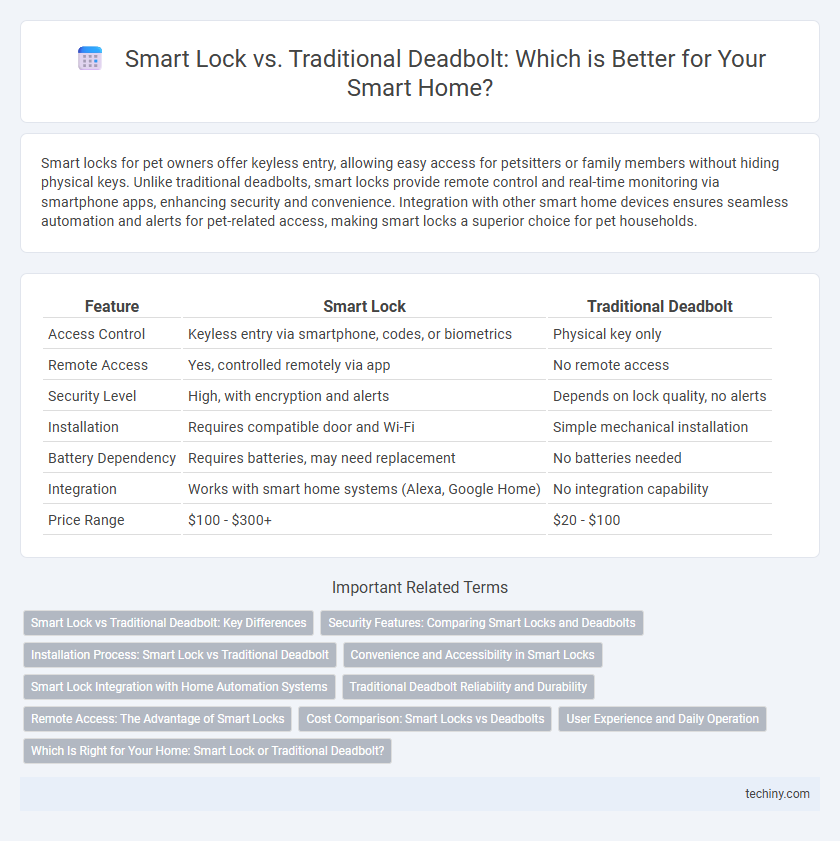Smart locks for pet owners offer keyless entry, allowing easy access for petsitters or family members without hiding physical keys. Unlike traditional deadbolts, smart locks provide remote control and real-time monitoring via smartphone apps, enhancing security and convenience. Integration with other smart home devices ensures seamless automation and alerts for pet-related access, making smart locks a superior choice for pet households.
Table of Comparison
| Feature | Smart Lock | Traditional Deadbolt |
|---|---|---|
| Access Control | Keyless entry via smartphone, codes, or biometrics | Physical key only |
| Remote Access | Yes, controlled remotely via app | No remote access |
| Security Level | High, with encryption and alerts | Depends on lock quality, no alerts |
| Installation | Requires compatible door and Wi-Fi | Simple mechanical installation |
| Battery Dependency | Requires batteries, may need replacement | No batteries needed |
| Integration | Works with smart home systems (Alexa, Google Home) | No integration capability |
| Price Range | $100 - $300+ | $20 - $100 |
Smart Lock vs Traditional Deadbolt: Key Differences
Smart locks offer remote access control and real-time monitoring, unlike traditional deadbolts which rely solely on physical keys. Integration with home automation systems allows smart locks to provide enhanced security features such as auto-locking and temporary access codes. Traditional deadbolts provide mechanical reliability but lack the convenience and flexibility of digital management found in smart lock technology.
Security Features: Comparing Smart Locks and Deadbolts
Smart locks offer advanced security features such as biometric access, remote control, and real-time alerts, enhancing home protection beyond traditional deadbolts. Traditional deadbolts rely on mechanical strength and physical keys, making them vulnerable to lock picking and key duplication. Integrating smart lock technology with home automation systems allows for comprehensive security management and increased convenience.
Installation Process: Smart Lock vs Traditional Deadbolt
Smart locks typically offer a straightforward installation process that often requires only basic tools and can be completed within 30 minutes, integrating seamlessly with existing door hardware. Traditional deadbolts usually demand precise drilling and alignment, potentially requiring professional installation to ensure security and proper function. Smart locks also provide user-friendly apps for configuration, eliminating the need for physical keys and enhancing overall convenience compared to traditional deadbolts.
Convenience and Accessibility in Smart Locks
Smart locks offer enhanced convenience by allowing remote access and keyless entry via smartphone apps, eliminating the need for physical keys. They provide flexible user management with temporary digital codes for guests or service providers, increasing accessibility without compromising security. Integration with smart home systems enables voice control and automation, further simplifying home entry and monitoring.
Smart Lock Integration with Home Automation Systems
Smart locks offer seamless integration with home automation systems, enabling remote access control and real-time monitoring through smartphone apps. Unlike traditional deadbolts, smart locks can connect to voice assistants, security cameras, and lighting systems to enhance overall home security and convenience. This integration allows automated locking schedules and instant alerts, improving user control and safety.
Traditional Deadbolt Reliability and Durability
Traditional deadbolts are renowned for their exceptional reliability and long-lasting durability, often crafted from solid steel components that withstand physical tampering and harsh weather conditions. Their simple mechanical design reduces the risk of electronic failure, making them a dependable choice for securing homes without relying on batteries or connectivity. This robustness ensures consistent performance over decades, making traditional deadbolts a trusted security option in the smart home ecosystem.
Remote Access: The Advantage of Smart Locks
Smart locks offer remote access capabilities that traditional deadbolts lack, allowing homeowners to lock or unlock doors from anywhere using a smartphone or internet-connected device. This remote control enhances security by enabling real-time monitoring and temporary access grants for guests or service providers. Integrating with home automation systems, smart locks provide seamless convenience and advanced control compared to manual, key-based deadbolts.
Cost Comparison: Smart Locks vs Deadbolts
Smart locks typically cost between $100 and $300, offering advanced features like remote access and integration with home automation systems, whereas traditional deadbolts range from $20 to $60, providing basic mechanical security without smart functionalities. Installation expenses for smart locks may be higher due to the need for compatible hardware and professional setup, while deadbolts are generally easier and cheaper to install. Over time, smart locks can save money through keyless access and enhanced security monitoring, potentially reducing costs related to lost keys or unauthorized entry.
User Experience and Daily Operation
Smart locks offer seamless user experience with keyless entry options such as PIN codes, fingerprint recognition, or smartphone integration, eliminating the need to carry physical keys. Daily operation is simplified through remote access and real-time notifications, allowing users to lock or unlock doors from anywhere and monitor entry activity. Traditional deadbolts rely on manual key insertion and lack remote control or tracking features, often resulting in slower access and increased risk of losing keys.
Which Is Right for Your Home: Smart Lock or Traditional Deadbolt?
Smart locks offer enhanced convenience with remote access, keyless entry, and integration with home automation systems, improving security through real-time notifications and temporary access codes. Traditional deadbolts provide proven mechanical reliability and do not rely on batteries or Wi-Fi, making them resistant to hacking and power failures. Choosing between a smart lock and a traditional deadbolt depends on your priorities for connectivity, ease of use, and security preferences within your smart home ecosystem.
Smart Lock vs Traditional Deadbolt Infographic

 techiny.com
techiny.com